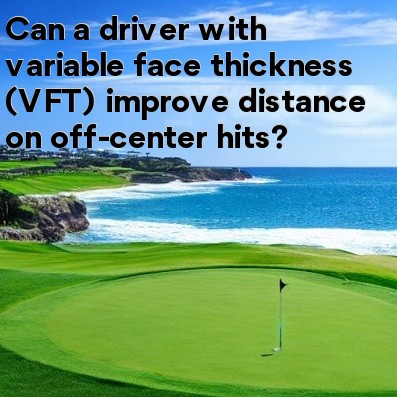
In golf, Can a driver with variable face thickness (VFT) improve distance on off-center hits?
One of the most important clubs in a golfer's bag is the driver. It is designed to deliver maximum distance off the tee, allowing players to cover more ground in a single shot. Over the years, golf technology has advanced significantly, and one of the latest innovations in driver design is the inclusion of Variable Face Thickness (VFT).
So, what exactly is Variable Face Thickness? It refers to a driver's clubface, which has different levels of thickness throughout its surface. Traditionally, clubfaces were flat and uniform, but with VFT, engineers have been able to strategically vary the thickness across the face. This variation helps to maximize ball speed and forgiveness, especially on off-center hits.
When a golfer strikes the ball with a driver, ideally, it should be struck in the center of the clubface. This is commonly referred to as the “sweet spot.” However, not every shot is perfectly executed, and many shots are struck towards the heel or toe of the clubface. These off-center strikes result in less ball speed and less distance.
This is where a driver with VFT comes into play. By having a variable face thickness, these drivers are designed to compensate for off-center hits. The areas of the clubface that are thinner provide a greater trampoline-like effect, helping to transfer more energy to the ball. This allows the ball to travel longer distances, even on shots that are not perfectly struck.
Furthermore, VFT technology also enhances the forgiveness of the driver. Forgiveness refers to a driver's ability to retain performance on mis-hits. With VFT, the increased trampoline effect helps to reduce the loss of distance and accuracy on off-center hits. Golfers often find that shots hit towards the heel or toe of the clubface still travel a decent distance and remain relatively on target.
It's important to note that while drivers with VFT can improve distance on off-center hits, they do not completely eliminate the effects of a mis-hit. The technology can only do so much, and to achieve the best results, golfers should still aim to make solid contact in the center of the clubface.
In conclusion, a driver with Variable Face Thickness (VFT) can indeed improve distance on off-center hits. The varying thickness across the clubface enhances the trampoline effect, allowing for more energy transfer to the ball. This results in longer shots, even when the ball is struck towards the heel or toe of the clubface. Additionally, VFT technology also boosts forgiveness, minimizing the loss of distance and accuracy on mis-hits. However, golfers should still strive for solid contact on the sweet spot for optimal performance.




